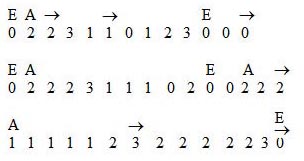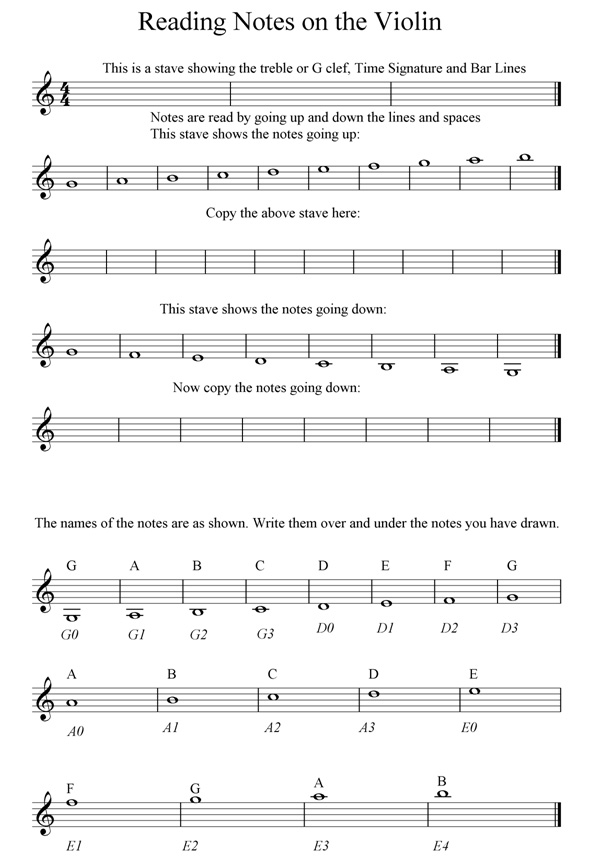The violin has four strings and a wooden bow holding horse hair. This simple idea is, in fact, the making of an incredibly beautiful sounding instrument which probably needs about 15 years of study to enable playing of the highest standard. One really needs a teacher, as the correct approach to technique is very important. Students will find it difficult to create an acceptable sound early on and so it is important not to spend too long learning any one piece for too long. It is more important to move on to new pieces, studies and scales without too much suffering. The additional benefit of this is that students become quicker at learning new material and mentally are kept alert. As long as practice is on a regular daily basis, a good attitude developing a good sense of self-discipline will become a good habit and bode well for the future. Basically the left hand needs to have the fingers organised into spacing that reflect the tones and semitones of scales.
- The first basic pattern to learn on each string is the first and second fingers a space with the third finger touching the second:
![]() As long as we are able to hold the bow correctly and play long slow bows we can learn simple tunes such as Twinkle Twinkle Little Star:
As long as we are able to hold the bow correctly and play long slow bows we can learn simple tunes such as Twinkle Twinkle Little Star:
Twinkle Twinkle Little Star
Repeat line 2
Now Play Line 1
And then:
Little Bird
Now play line 2
Go Tell Aunt Nancy
Now play line 1
Drunken Sailor

Once the above melodies have been learned, it is necessary to learn to read music. The following shows the necessary information to achieve this aim, with exercises included to ensure the necessary understanding:
Just to clarify matters, the following chart can be completed:
You may now feel ready to buy a book of first pieces. I find that it is better to learn well known tunes rather than use beginner pieces which try to simplify the learning process by creating simplified tunes. A really good book is Winners Galore by Peter Lawrence published by Brass Wind Publication. Following this I suggest the ABRSM Publication, Baroque Pieces book 1 followed by book 2.
As well as learning tunes, it is important to learn scales to find out about all the different finger patterns. From my publications section you can purchase my own scale manuals, produced in two volumes, presented in a very clear manner to encourage a unique understanding of scales as the system is very easy to use once you get used to it.
The next item necessary for developing technique in addition to the above is a study book. The ABRSM publishes a unique series of study books which, although published long ago, remain unsurpassed in quality.
1) How to use 50 Elementary studies by Rowsby Woof:
Generally, your approach should be to learn the studies with sharp keys first returning to flat key studies later. Learn a small section of the study first and gradually increase the amount you learn until you can learn a whole study in one go if you wish. For sharp keys learn numbers 1,3,6,12,21,22,and 29. Then return to the beginning of the book to learn numbers 4,16,25 and 43. You can then also learn numbers 17,18 and 20.
Having completed this study book, I suggest:
2) Elementary Progressive Studies Book 1 by Herbert Kinsey.
I suggest completing the studies in the following order: 4,5,6,7,8,9,11,12,14,16,17,19,21,23,ane then 24.
3) A Tuneful Introduction to Third Position by Neil Mackay.
It is important to learn, as early as possible, third position ( this means the third finger position is replaced with the first, thus raising the left hand to a higher playing position. It is not worth learning all the tunes as the aim is to learn the basic finger position in third position, as detailed at the beginning of this article. It starts with tunes on one string and then introduces melodies on two strings. The last section with melodies on all four strings is not worth learning as I suggest you go on to the following:
4) 30 Studies of Moderate Difficulty, Published by ABRSM.
This book teaches you the different finger positions in third position on all four strings. Studies should be learned in the following order: 1,2,3,5,8,11,12,14,15,18,17,20,21,22, and 23.
5) Elementary Progressive Studies Book II by Herbert Kinsey, Published by the ABRSM:
Complete studies should be learned in the following order: 1,3 (leave out last 8 bars!), 5,7,9,10,15,17 and 21.
6) Elementary Progressive Studies Book III by Herbert Kinsey, Published by the ABRSM:
The order to learn these studies in is 1-4, 6-8, 10,12,17, and 18.
You should now be competent enough to tackle many interesting and exciting pieces and at about grade V standard!




